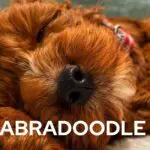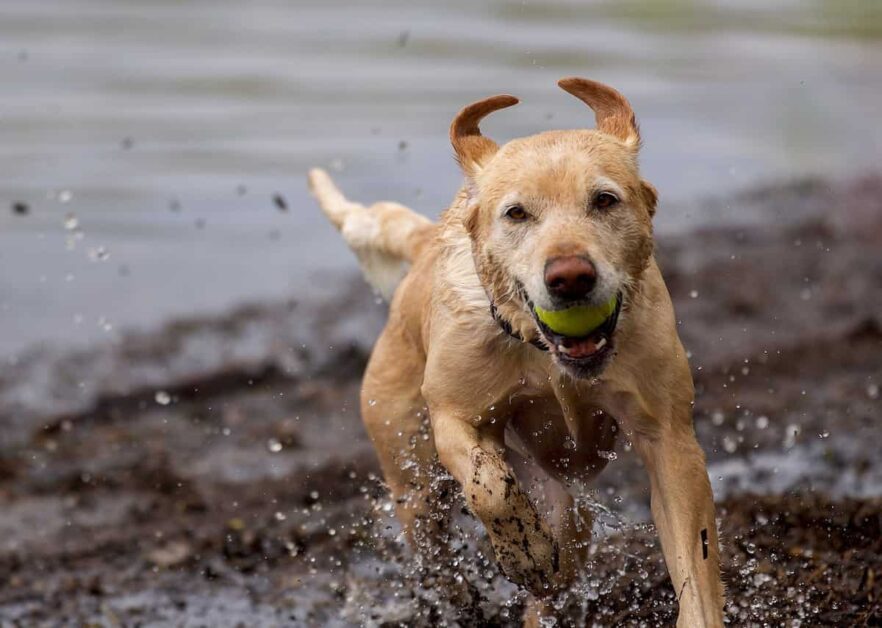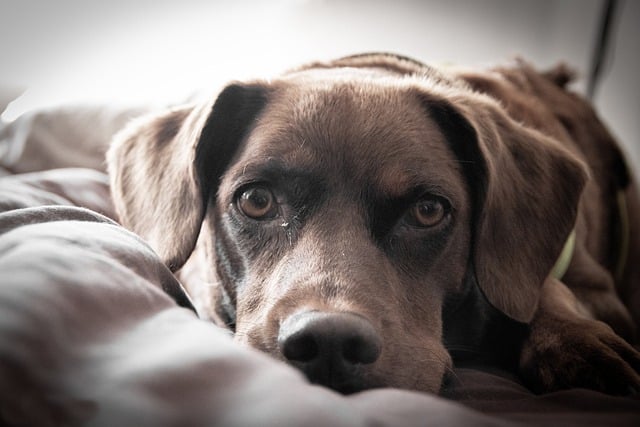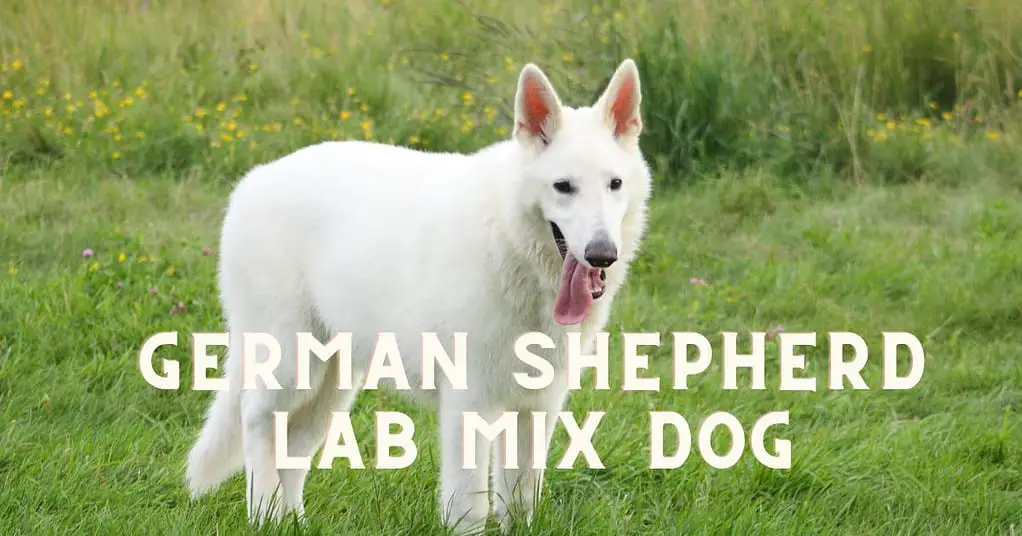Labradoodles are considered low-shedding dogs, especially those with a fleece or wool coat. However, some Labradoodles may have a hair coat, which can shed more. There is no such thing as a completely hypoallergenic dog, but Labradoodles are often marketed as a good choice for people with allergies.
This is because their curly coat traps dander, the main allergen found in dog hair. However, it is important to note that dander can also be found in a dog’s saliva and skin, so even a low-shedding dog like a Labradoodle can still trigger an allergic reaction in some people
This blog post provides a comprehensive guide on why your Labradoodle might be shedding, how much shedding to expect, and steps you can take to manage it effectively.
Type of Hair Does a Labradoodle Have?
Labradoodles have three main types of coats: straight, wavy, and curly.
Straight
Straight-hair Labradoodles have flat coats. They get this from not having the curly coat gene of a Poodle. Even though they may shed more than curly-coated Labradoodles, they can also be hypoallergenic.
They don’t shed as much as purebred Labrador Retrievers. This type of coat does not change that they are still true Labradoodles!
Wavy
Labradoodles can have wavy hair. It’s a type of coat that is not straight but also not very curly. This hair type may shed a little, but not too much.
The loose waves are pretty, but they don’t hold in all the stuff that makes people sneeze like dander and dead skin cells.
First generation Labradoodles often have this kind of wavy coat. Their loose curls make them good at trapping shedding hair inside their coat. But if you or someone in your family gets allergies easily, these dogs might not fit you best.
Curly
Curly hair is a common coat type for Labradoodles. Dogs with curly coats shed less than those with straight or wavy hair. The tight curls of the wool coat help to trap dead skin cells and loose hair.
This trait makes curly-haired Labradoodles great pets for people with allergies. Remember, the dog’s parents’ breed can affect this; a poodle parent will add tighter curls than a Labrador retriever parent.
You must brush your dog daily to keep its coat healthy, remove dead skin particles, and control shedding.

Labradoodle Shedding Guide
Labradoodle shedding can vary depending on their hair type, how often they shed, and why they may be shedding excessively.
How Much Does a Labradoodle Shed?
Labradoodles shed fur, but the amount they shed can vary. Most Labradoodles are low-shedding because of their Poodle genes. However, Labradoodles with more Labrador Retriever ancestry may shed more than those with more Poodle ancestry.
If you’re concerned about shedding, it’s best to choose a Labradoodle that has more Poodle in its genes as they are less likely to shed heavily.
Which Generations of Labradoodles Shed the Most?
Labradoodles are a popular breed known for their low shedding coats. However, not all Labradoodles shed the same amount. When it comes to shedding, the generations of Labradoodles play a role.
F1 (first generation) Labradoodles tend to shed more than other generations. This is because they are more likely to inherit the Labrador Retriever’s genes, which can contribute to more shedding.
On the other hand, Labradoodles with more Poodle genetics are less likely to shed. So if you’re looking for a Labradoodle that sheds less, consider getting one with a higher percentage of Poodle ancestry or belongs to a later generation like F2 or Multigenerational breeding.

How often does a Labradoodle shed?
Labradoodles shed like any other breed but are generally low shedding. The frequency of shedding can vary from dog to dog. Some Labradoodles may only shed a little hair occasionally, while others may shed more frequently.
It’s important to note that Labradoodles with a wavy or curly coat tend to shed less than those with a straight coat. Labradoodles with more Poodle ancestry are more likely to have low-shedding characteristics.
While Labradoodles do shed, they are considered a good option for people who want a hypoallergenic and low-shedding dog.
Why is my Labradoodle Shedding so Much?
Labradoodles may shed a lot due to various reasons. One reason is seasonal changes, with Labradoodles having thicker fur in winter and shedding more during warmer months.
Another reason could be stress or anxiety caused by changes in their social environment. Inadequate nutrition can also contribute to excessive shedding. Providing your Labradoodle with a balanced diet with Omega 3 and MSM supplements can help reduce shedding.
Remember, while Labradoodles are often considered non-shedding or hypoallergenic, they do shed, although the amount can vary depending on genetics.
By understanding the reasons behind their shedding and taking appropriate measures like proper grooming and nutrition, you can effectively manage your Labradoodle’s shedding.
How To Groom your Labradoodle?
When grooming your Labradoodle, it is important to regularly bathe and brush them to keep their coat healthy and free from tangles.
Bathing
Labradoodles need regular bathing to keep their coats clean and healthy. Most Labradoodles should be bathed every 2 to 3 weeks, but this can vary depending on the time of year and how dirty they get.
Good breeders may already start basic grooming, including bathing, before you adopt your Labradoodle. While some Labradoodles might only need a bath once a month, groom them at least twice a month to keep their coat looking its best.
Regular baths will help keep your Labradoodle smelling fresh and prevent any skin issues from happening.
Brushing
Regular brushing is an important part of grooming for Labradoodles. A weekly brushing session helps to keep their coats healthy and reduces shedding. By brushing your Labradoodle often, you can prevent tangles and mats from forming in their fur.
Having them professionally groomed every 6-8 weeks is recommended, but regular brushing at home is still necessary to maintain their beautiful coats.
So grab a brush and spend some quality time with your Labradoodle while keeping their coat looking its best!

Trimming
Labradoodles need regular trimming to keep their fur looking neat and tidy. Most Labradoodles should have their fur trimmed every two to three months, although some may require more frequent trims.
Trimming can be done every six to eight weeks for a well-maintained coat. If your Labradoodle has a non-shedding coat, it must also visit the groomer every four to twelve weeks for a haircut.
Detailed grooming is necessary every few months, regardless of whether your Labradoodle sheds or not. Regular trimming helps keep their coat healthy and prevents matting and tangling.

Labradoodle Haircuts
Labradoodles have thick coats that require regular grooming and haircuts to keep them looking their best. Labradoodles has different haircut styles, such as the puppy cut and the teddy bear cut.
These haircuts help to keep the Labradoodle’s coat manageable and prevent it from matting or tangling. Shaving a Labradoodle is generally not recommended because their coat serves as protection against the elements.
Instead, regular trimming every few months is necessary to maintain their coat’s health and appearance.
How to Stop Labradoodle Shedding?
To stop Labradoodle shedding, consistently brush your dog, provide adequate nutrition, wash them regularly, and manage their stress. Want to know more tips? Keep reading!
Consistently Brush Your Labradoodle
Regularly brushing your Labradoodle is essential for managing shedding and keeping their coat healthy. By using a slicker brush, you can remove loose hairs, dirt, and dander that can contribute to shedding.
Brushing also helps prevent matting, which can be uncomfortable for your Labradoodle. Make sure to establish a consistent brushing routine to keep their coat in good condition and minimize shedding.

Provide Adequate Nutrition
Labradoodles need a healthy and balanced diet to maintain a strong coat. Their diet should include high-quality protein, such as meat or fish, which helps with hair growth and strength.
Grains and fruits can also provide necessary vitamins and minerals for their overall health. If Labradoodles have skin allergies, specific dietary considerations may be needed.
Ensuring they receive adequate nutrition is important in keeping their coat healthy and preventing any issues related to hair loss or weakness.
Wash Your Dog Regularly
To keep your Labradoodle clean and healthy, it’s important to wash them regularly. The frequency of bathing depends on how messy they get, but most dogs don’t need a bath more than once a month.
Washing helps remove dirt and allergens from their coat, keeping them fresh and odor-free. Use dog-friendly shampoo and make sure to rinse thoroughly to avoid any irritation.
Regular baths also give you the opportunity to check their skin for any issues or abnormalities.
Manage Your Labradoodle’s Stress
Stress can make Labradoodles lose fur, so managing their stress levels is important. One way to do this is by providing them with a calm and peaceful environment. Make sure they have a comfortable bed, plenty of toys to play with, and regular exercise to keep them active and happy.
Another way to reduce stress is by sticking to a routine. Labradoodles thrive on structure, so try to feed them simultaneously every day and establish regular playtime and grooming sessions.
Additionally, consider using calming techniques such as music or aromatherapy specifically designed for dogs. By reducing your Labradoodle’s stress levels, you can help minimize shedding and keep their coat healthy and beautiful.

What’s the shedding experience of actual Labradoodle owners?
Labradoodle owners have different experiences with shedding. Some Labradoodles shed very little or not at all, making them ideal for individuals with allergies. These Labradoodles usually have curly or wavy coats that trap loose hair and prevent it from falling out.
On the other hand, Labradoodles with straighter coats may shed more. While shedding can vary among individual dogs, many Labradoodle owners find that regular grooming and brushing help manage shedding effectively.
Here are some anecdotal reports from Labradoodle owners about their shedding experiences:
- “I have a Labradoodle with a fleece coat, and he barely sheds at all. I only have to brush him once a week, and I never find any hair around the house.”
- “My Labradoodle has a hair coat, and he sheds a little more than my other dog with a fleece coat. I still don’t find it to be too bad, but I do have to brush him more often.”
- “I have a Labradoodle mix, and he sheds a lot. I have to brush him every day, and I still find hair all over the house.”

FAQs : labradoodle hypoallergenic dog
How can I tell if my Labradoodle will shed?
Labradoodles can have different types of coats, including straight, wavy, and curly. While Labradoodles are generally considered to be low-shedding to non-shedding dogs, it ultimately depends on their individual genetics.
If your Labradoodle has inherited more genes from their Labrador parent, they may shed more like a Labrador Retriever.
On the other hand, if they inherit more genes from their Poodle parent, they are less likely to shed and may have a hypoallergenic coat.
Occasional shedding can still occur even in non-shedding Labradoodles.
Are there different coat types for Labradoodles?
Labradoodles can have different coat types, such as wavy, curly, fleece, wool, or hair. The most common coat type is the fleece coat, which is low shedding and soft to the touch. Labradoodles can also come in various colors like golden, golden red, and brown.
Understanding the different coat types when considering a Labradoodle as a pet is important because some may require more grooming than others.
Is a Labradoodle a good family dog?
Labradoodles are considered to be a good family dog. They have a friendly and gentle temperament that is well-suited for families with children. Labradoodles are also known for being loyal and sociable, making them great companions for both kids and adults.
Additionally, Labradoodles have a longer lifespan than other breeds, so they can be part of the family for many years.
Another advantage of Labradoodles is that they shed less than other dogs, making them a suitable choice for people with allergies or prefer cleaner homes.
The breed was actually created to be hypoallergenic by crossing Labrador Retrievers and Poodles. Overall, Labradoodles make loving and adaptable pets that can bring joy to any family.
How Labradoodle Parents Rated Their Pups’ Hypoallergenic Levels
Labradoodle parents took part in a survey to rate how hypoallergenic their puppies were. The goal was to clear up the misconception that Labradoodles don’t shed at all.
Although Labradoodles are often seen as hypoallergenic because of their Poodle genes, not all Labradoodles will be allergy-friendly.
Some breeders may claim that Labradoodles are completely hypoallergenic and low-maintenance, but that’s not entirely accurate. Labradoodles can have different coat types, like curly, wavy, or straight, with varying levels of shedding.
How Do You Tell If A Labradoodle Will Be Curly?
Labradoodles can have different types of coats, including straight, wavy, and curly. If you want to know if a Labradoodle will be curly, there are a few things to look for. Labradoodles with a wavy coat are more likely to be curly as they grow older.
You can also observe the hair around their face and muzzle area – if it’s thick and fluffy, chances are they’ll have a curlier coat. Labradoodles with 75% or more nonshedding Poodle genetics typically have a wavy or curly coat that doesn’t shed much.
Which Labradoodles Don’t Shed?
Labradoodles with a curly or wool coat are less likely to shed than those with a straight or wavy coat. Labradoodles that have inherited more of the Poodle gene usually don’t shed as much.
However, no Labradoodle is completely non-shedding and hypoallergenic. Shedding can still occur but may be reduced in Labradoodles with curlier coats.
It’s best to consult with a breeder or spend time with different Labradoodles to see which one suits your needs regarding shedding levels.
Which Labradoodle Generation Sheds the Least?
The Labradoodle generation that sheds the least is F3. Labradoodles need at least three generations to produce non-shedding results consistently. The more Poodle genes a Labradoodle has, the higher the chance of not shedding.
Through selective breeding, labradoodle shedding can be reduced. Compared to other dog breeds, Labradoodles shed significantly less hair.
Do I Have to Groom a Labradoodle Puppy?
Yes, you do have to groom a Labradoodle puppy. Labradoodles have hair that grows continuously and can become tangled or matted if not properly cared for. Regular grooming is important to keep their coat healthy and looking good.
This includes brushing their hair daily to prevent tangles and mats and taking them to the groomer every six weeks for a professional trim. Grooming also helps to remove loose hair and minimize shedding, keeping your home cleaner.
How Often Should I Groom my Adult Labradoodle?
Grooming your adult Labradoodle is important to keep their coat healthy and free from mats. Generally, you should groom your Labradoodle at least once a week.
However, the frequency can vary depending on the type of coat your Labradoodle has.
If your Labradoodle has a curly coat, they may require more frequent grooming to prevent matting. On the other hand, if your Labradoodle has a straight or wavy coat, once a week grooming may be sufficient.
Are Labradoodles high maintenance?
Labradoodles can be high maintenance, especially when they are puppies. They require a lot of attention and care during their early years. However, Labradoodles tend to calm down and become less demanding as they grow older.
While Labradoodles may not be as low maintenance as some people think, regular grooming and proper care can help keep them healthy and happy. It’s important to remember that every dog is different and their maintenance needs can vary.
Are boy or girl Labradoodles better?
When choosing between a male and female Labradoodle, consider size, trainability, energy level, and health factors. Breeders and owners have no clear consensus about which gender is better.
Male Labradoodles are often described as more affectionate and energetic, while female Labradoodles are considered to be less likely to run away. However, both genders have the same average lifespan and are prone to similar health issues.
Understanding the difference between F1 and F1b Labradoodles can also help select a puppy. So ultimately, the decision comes down to personal preference and what qualities you value most in a furry companion.
Can Labradoodles be left alone?
Labradoodles can be left alone for a few hours, but taking precautions is important because they are social dogs. However, no dog, including Labradoodles, should be left alone for more than 4 hours.
Labradoodles are not known for tolerating being left alone very well and can become anxious when separated from their owners. It’s best to provide them with companionship or hire a pet sitter if you need to leave them for an extended period.
Labradoodles should not be kept outside for long periods as they thrive on human interaction and may experience distress if left alone in the yard without any company or stimulation.
Do Australian Labradoodles shed a lot?
Australian Labradoodles are generally considered to be a low-shedding or even non-shedding breed. While shedding can vary from dog to dog, Australian Labradoodles with more Poodle genetics tend to have a coat that sheds less.
This makes them a great choice for people with allergies or prefer a cleaner home environment. However, it’s important to note that no dog is completely hypoallergenic and individual dogs may still produce some dander or allergens.
Author Profile
- Site Owner And Planning Specialist
-
Aritra, the founder of Labradorandyou.com, is a lifelong dog lover whose passion ignited for Labradors for their loyalty and intelligence. With extensive research and personal experiences, Aritra has become a Labrador expert, offering a rich resource on the breed. Labradorandyou.com provides reliable, timely, and evidence-based information, including Labrador-specific product reviews, training techniques, and care tips.
Labradorandyou.com was born out of Aritra's passion and his desire to share his profound knowledge about the breed. The site serves as a comprehensive resource, offering a wealth of up-to-date information for Labrador owners and enthusiasts alike
Also by the author
-
 FAQNovember 17, 2023How To Adopt An Emotional Support Dog?
FAQNovember 17, 2023How To Adopt An Emotional Support Dog?
-
 Mix-BreedsNovember 16, 2023Red Labradoodle Ultimate Guide: Breed Facts, Care Tips
Mix-BreedsNovember 16, 2023Red Labradoodle Ultimate Guide: Breed Facts, Care Tips
-
 Top BreedersNovember 8, 2023Breeding Labradors: Everything You Need to Know
Top BreedersNovember 8, 2023Breeding Labradors: Everything You Need to Know
-
 FAQOctober 17, 2023Do Dogs Like Music? Researchers Say Yes! Find Out
FAQOctober 17, 2023Do Dogs Like Music? Researchers Say Yes! Find Out





